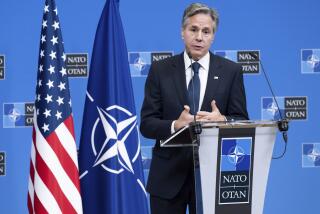A Military’s Power Isn’t in the Numbers
- Share via
United States “special operations” in Afghanistan have been far from dramatic. So far, there has been only one classic commando-style raid and it was nothing more than a straightforward helicopter descent that encountered no resistance.
Yet there is no doubt that U.S. elite soldiers on the ground have achieved spectacular results in a new and powerful synergy with air power. There is a lesson on military spending in this for Europe.
In the 1999 Kosovo war, targets could be bombed precisely almost every time, but there was nobody on the ground to identify moving targets for aircraft overhead. As a result, only buildings and infrastructure could be destroyed, not the Serbian forces terrorizing Kosovo’s Albanians into flight. There were local allies--the loose bands of the Kosovo Liberation Army--but there were no advisor teams to channel supplies, to motivate and coordinate and to ensure close air support.
With or without local allies, the new synergy of elite forces with air power has become the essential military instrument of today--and a very economical one. It is myth that only the U.S. can afford the cost. It is a question of will and priorities rather than of budgets.
That is why little Israel has the new capability on a rather large scale with a military budget only half that of Italy’s and one-third that of Britain or France, deducting the cost of their nuclear forces.
By now it is widely understood that precision bombing itself is not only effective but also relatively cheap: About 6,000 guided bombs (more than were used in Kosovo or Afghanistan) can be purchased for the price of three fighters of the Tornado/Rafale class. Giving up a couple more will pay for all the other components large and small, from remotely piloted air vehicles for overhead observation to hand-held laser equipment. And because precision greatly reduces the need for numbers (one guided bomb replaces dozens of unguided ones), air forces can be smaller and yet much more powerful.
It is the same for the elite troops needed on the ground. True, they are costly individually to maintain, yet they are cheap collectively because the total number required is small. It is not their mostly prosaic equipment that makes elite units expensive but their training. Serious training is both expensive and the only true source of combat capability. It was not supermen the U.S. sent to Afghanistan but well-trained men.
Even the U.S. Rangers at the bottom of the elite hierarchy receive six months, not six weeks, of individual instruction in infantry skills before joining their units. New recruits in the U.S. Special Forces, the Green Berets--who have done so well in supporting Tajik, Uzbek, Hazara and Pushtun bands--receive even more training in everything from field medicine to foreign languages, in addition to weapons and tactics. The small Delta battalion and its Air Force and Navy counterparts never stop training at all.
Every helicopter flight hour costs thousands of dollars, and elite forces use helicopters all the time for their training, along with much else, from lots of ammunition to the services of language teachers. But again the total cost is small because elite troops are so few.
European armies that keep large numbers of soldiers who are unfit and unprepared for any kind of combat could replace many of them with elite units at equal cost.
There’s no doubt that the lives of officers are less comfortable when training is for real. It’s far easier to pretend that the training of the line forces is sufficient and to exaggerate the quality of any elite unit that exists, even if it’s only elite by local standards. Only determined political and military leadership can overcome bureaucratic resistance to real training, but the reward is to have real military capabilities, which are needed even for peacekeeping operations if they are actually to keep the peace.
Now that the U.S. has shown both the power and the economy of synergistic warfare--the entire Afghan war has cost less than 2% of the annual defense budget--it will be interesting to see how European governments react. European leaders have been seeking roles for their armed forces in the Afghanistan war and its peacekeeping aftermath. If they had effective forces, it is the Americans who would do the asking.
More to Read
Sign up for Essential California
The most important California stories and recommendations in your inbox every morning.
You may occasionally receive promotional content from the Los Angeles Times.













